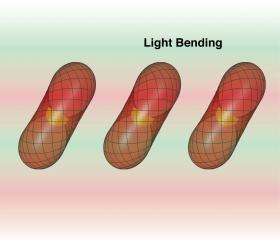March 3, 2009 feature
Scientists Create Light-Bending Nanoparticles

(PhysOrg.com) -- Metallic nanoparticles and other structures can manipulate light in ways that are not possible with conventional optical materials. In a recent example of this, Rice University researchers discovered that cup-shaped gold nanostructures can bend light in a controllable way. The cups act like three-dimensional nano-antennas.
The research is described in the February 19, 2008, online edition of Nano Letters.
When light interacts with nanoparticles and other tiny structures, many interesting and even dramatic physical effects can occur. For example, man-made "metamaterials" have very fine structures with features smaller than the wavelength of light, some just tens of atoms across, imparting them with unique and often intriguing optical behaviors. Metamaterials are of interest to scientists because they may be able to interact with light in ways that naturally occurring materials cannot.
The gold nanocups created in this research interact with light in two main ways: axially, the up-down direction, or transverse, the left-right direction. The transverse mode is by far the stronger of the two.
"When we illuminated the nanocups, the transverse interaction exhibited a strong scattering resonance," said Rice University researcher Naomi Halas, the study's corresponding scientist, to PhysOrg.com. She conducted the study with colleague Nikolay Mirin. "We learned that the direction of the transverse resonant light scattering depends on the orientation of the cups, a property that has not been observed in studies of similar structures."
Specifically, the cups behave like a "split-ring resonator," a type of metamaterial with a negative refractive index—the ability to refract (not reflect) light partially or fully backward. Split-ring resonators look like two concentric, non-touching rings that have each been split in half. When placed in a microwave or infrared field, an alternating current of that same frequency is induced in each ring. Each current in turn induces its own magnetic field at that same microwave or infrared frequency, which can either oppose or enhance the original field.
Split-ring resonators can support resonant wavelengths that are much larger than their size. But since split-ring resonators are flat, their light-scattering abilities are restricted to a plane.
Halas and Mirin's nanocups are much like three dimensional versions of split-ring resonators. When light with the proper frequency is applied, a resonant electron current is induced in the cups. This current produces an electric field that is parallel to the cup opening (not parallel to the cup axis). The scattered light is emitted perpendicular to that field; in other words, in whatever direction the cup's axis is pointing.
This unique light-redirecting property should prove to be very useful in the development of new optical materials and devices, from solar cells to light attenuators to chip-to-chip optical interconnects in futuristic circuitry.
"In this line of research, many other types of nanoparticles and nanostructures can be designed to have this type of light-redirecting property," said Halas.
Halas and Mirin created the nanocups by depositing latex or polystyrene nanoparticles, each about 80 nanometers in diameter, onto a sheet of glass. They coated the particles and the glass with a 20-nanometer-thick layer of gold, applying the gold from different angles to make sure both the sides and tops of each particle were covered, yet leaving an uncoated circular or elliptical "shadow" next to each particle, exposing the surface below.
Finally, they poured an elastic polymer was poured over the array and, when the polymer had cured, peeled it off to reveal a transparent film embedded with gold nanocups.
More information: Nano Lett., Article ASAP • DOI: 10.1021/nl900208z
Copyright 2009 PhysOrg.com.
All rights reserved. This material may not be published, broadcast, rewritten or redistributed in whole or part without the express written permission of PhysOrg.com.





















